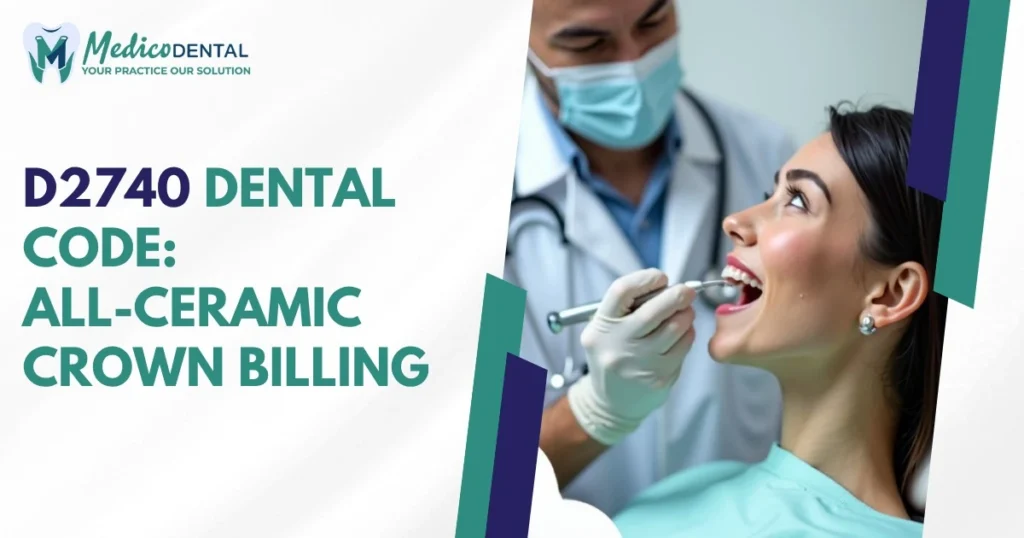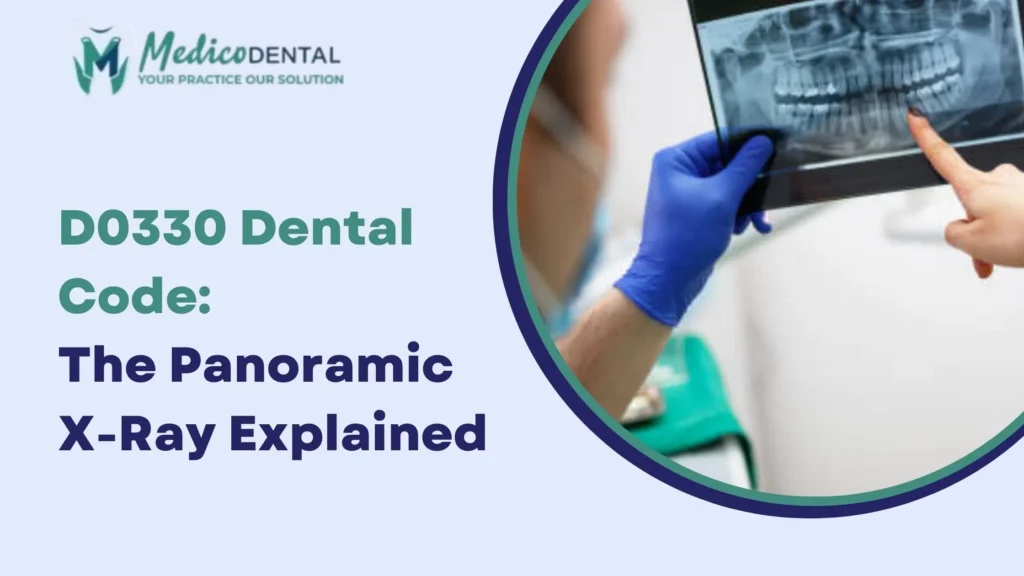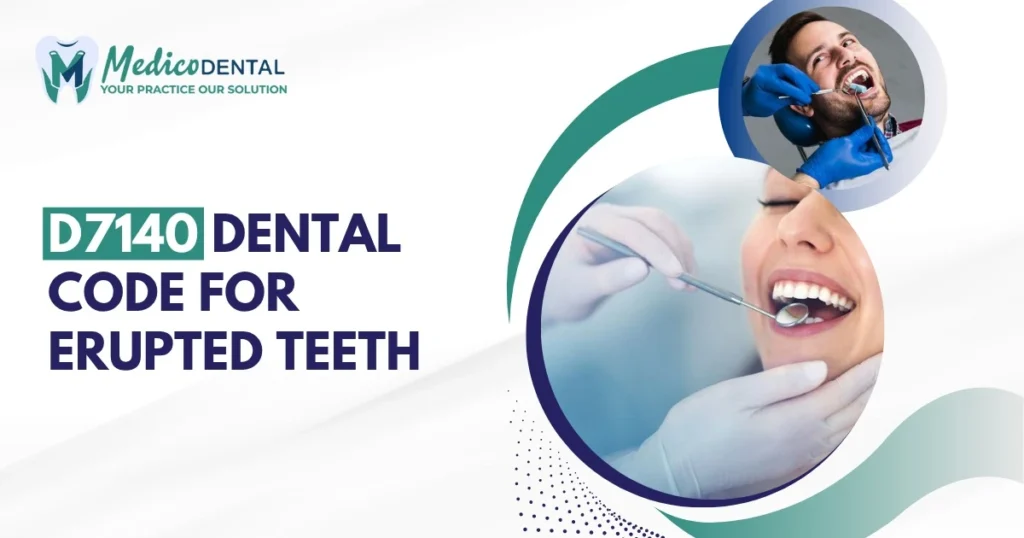When a tooth becomes weak, decayed, or fractured, a crown is often the most effective solution to restore both its function and natural appearance. The D2740 dental code represents a porcelain or ceramic crown used in such restorative cases. Understanding this code is essential for dental professionals, billing staff, and even patients, as it ensures accurate procedure documentation and proper insurance reimbursement. Let’s explore what the D2740 code means, when to use it, and how it impacts dental billing.
What Is the D2740 Dental Code?
Definition and Purpose of D2740
The D2740 dental code identifies a dental procedure involving a full coverage crown made entirely of porcelain or ceramic material. This crown covers the entire visible portion of the tooth, restoring its structure, aesthetics, and strength.
The purpose of using this code is to document the placement of crowns that contain no metal and are designed to blend seamlessly with the natural teeth. It provides both dental teams and insurance carriers with a standardized way to record and process this specific treatment type.
Why Dentists Use the D2740 Code
Dentists use the D2740 code when restoring teeth that require a crown made purely from porcelain or ceramic materials. These crowns are highly popular for front teeth or any visible areas of the mouth because of their realistic color and translucency.
This code ensures:
- Correct billing for the exact crown type used
- Distinction from metal or porcelain fused to metal restorations
- Streamlined insurance claim submissions
In short, the D2740 code allows dentists to provide cosmetic and functional restorations while maintaining billing accuracy and patient clarity.
Description of the D2740 Procedure
Full Coverage Crown Details
The D2740 procedure involves placing a custom made crown that covers the entire visible part of a damaged or weakened tooth.
The typical process includes:
- Tooth preparation Removing decay and reshaping the tooth to make space for the crown.
- Impression or digital scan Capturing the exact shape of the tooth and bite alignment.
- Temporary crown placement Protecting the tooth while the permanent crown is fabricated.
- Permanent crown cementation The porcelain or ceramic crown is securely bonded to the tooth for a natural and durable result.
The result is a restoration that not only strengthens the tooth but also improves its appearance and functionality.
Material Used Porcelain or Ceramic Substrate
Crowns under the D2740 dental code are fabricated entirely from porcelain or ceramic materials. These materials are chosen for their:
Natural look: They closely resemble tooth enamel.
Durability: Modern ceramics, including zirconia and lithium disilicate, are strong and long lasting.
Biocompatibility: Suitable for patients with metal sensitivities or allergies.
Porcelain and ceramic crowns provide exceptional aesthetics, making them ideal for anterior teeth or any area where appearance is a priority.
Difference Between D2740 and Other Crown Codes
The D2740 code is distinct from other crown codes primarily due to the material used.
Here’s how it differs:
D2750:Porcelain fused to high noble metal
D2752: Porcelain fused to noble metal
D2790: Full cast high noble metal crown
While these codes involve metal-based restorations, D2740 applies only to all-porcelain or all-ceramic crowns. This distinction ensures precise coding and prevents claim denials or downgrades. Additionally, understanding related procedural codes such as the D7953 Dental Code, which involves bone graft procedures, helps dental professionals maintain accuracy and compliance across all restorative and surgical treatments.
When to Use D2740 Dental Code
Ideal Clinical Scenarios
The D2740 dental code is appropriate in cases where a full coverage, metal free restoration is required. Common scenarios include:
- A tooth with extensive decay or structural damage
- Fractured or chipped teeth needing strength and aesthetics
- Replacement of large fillings that can no longer support the tooth
- Cosmetic enhancement for discolored or misshapen teeth
Dentists often prefer this code for front teeth because porcelain and ceramic crowns offer a natural and attractive finish.
Tooth Restoration After Damage or Root Canal
After a root canal treatment, the tooth structure becomes more fragile and prone to cracking. In such cases, a D2740 porcelain or ceramic crown provides complete coverage and protection, restoring the tooth’s strength.
Similarly, when a tooth is weakened by decay, trauma, or large restorations, this crown code ensures a durable and aesthetic restoration that enhances both appearance and function.
D2740 Dental Code and Insurance Billing
Reimbursement Guidelines
When submitting claims for the D2740 dental code, it’s important to verify the patient’s dental insurance plan. Coverage for porcelain or ceramic crowns may vary depending on:
- The reason for the procedure (restorative vs. cosmetic)
- The location of the tooth (front or back)
- Plan limitations or annual maximums
Most insurance companies cover D2740 crowns if they are medically necessary to restore the tooth’s function, not just for cosmetic reasons.
Factors That Affect Insurance Coverage
Several factors can influence how insurance providers reimburse claims for D2740 crowns, including:
Tooth location: Anterior teeth are more likely to be covered due to aesthetics.
Type of material used: Some plans downgrade reimbursement to a metal crown rate.
Supporting documentation: Lack of proper justification can result in partial or denied claims.
To prevent issues, dental offices should always confirm benefits and explain potential out of pocket costs to patients in advance.
Documentation Tips for Successful Claims
Accurate documentation plays a major role in claim approval for the D2740 dental code. For smoother reimbursement, dental teams should:
- Include X rays and intraoral photos showing damage or decay.
- Provide clinical notes explaining why the crown was necessary.
- Clearly state the material used porcelain or ceramic in the claim narrative.
- Attach lab invoices or digital scan data when available.
Thorough documentation not only supports claim validity but also helps avoid unnecessary delays or downgrades from insurance companies.
Patient Considerations
What Patients Should Know Before the Procedure
Before getting a D2740 crown, patients should be aware of what the procedure involves and what to expect afterward. The dentist will first prepare the tooth by removing damaged areas and reshaping it to accommodate the crown. A temporary crown may be placed while the permanent porcelain or ceramic crown is being fabricated in a dental lab.
Patients should also understand:
- The material used (porcelain or ceramic) is chosen for its natural appearance and durability.
- Crowns may last between 10 to 15 years or longer with proper oral hygiene.
- Mild sensitivity after the procedure is normal but typically resolves quickly.
Knowing these details helps patients make informed decisions and set realistic expectations about treatment outcomes and maintenance.
Common Mistakes When Using D2740
Coding Errors to Avoid
Accurate dental coding is essential for both compliance and reimbursement. However, the D2740 dental code is often misused due to confusion with other crown codes. Common errors include:
- Using D2740 for porcelain fused to metal crowns (which should be coded as D2750 or D2752).
- Submitting D2740 for implant crowns instead of natural tooth restorations.
- Failing to specify the crown’s material type in the claim narrative.
Incorrect coding not only delays claim approval but may also result in insurance denials or reduced reimbursement. Proper code selection and clear documentation prevent these issues.
How to Ensure Proper Claim Submission
To ensure a successful claim submission for the D2740 code, dental teams must provide thorough and accurate information. This includes:
Clinical justification: Clearly document why a crown was necessary (e.g., tooth fracture, extensive decay, or failed restoration).
Material details: Specify that the crown is made of porcelain or ceramic, not metal.
Supporting evidence: Attach X rays, intraoral photos, and chart notes that confirm the clinical need.
Pre authorization: When possible, submit pre treatment estimates to confirm coverage before the procedure.
By following these steps, dental offices can minimize claim rejections and ensure prompt reimbursement while maintaining transparency with patients.
D2740 Dental Code vs Other Crown Codes
Comparison with D2750 and D2783
While the D2740 code applies to all porcelain or all ceramic crowns, there are several other crown codes used in restorative dentistry, each based on material composition and application.
Here’s how D2740 compares with other common codes:
D2750 Porcelain fused to high noble metal
This code is used when a crown combines porcelain on the outer layer with a high noble metal base for added strength.
D2783 Crown, 3/4 porcelain/ceramic
This code represents a partial coverage crown, unlike D2740, which is full coverage.
The key distinction lies in the extent of coverage and material type. D2740 is strictly for full coverage crowns made entirely of porcelain or ceramic with no metal substructure. Choosing the correct code ensures precise documentation, accurate billing, and compliance with dental insurance standards.
Choosing the Right Code for Your Case
Selecting the correct crown code depends on multiple factors including:
Material used: Is the crown all ceramic or does it include metal?
Extent of restoration: Is it full or partial coverage?
Tooth location: Front teeth often benefit from all ceramic crowns for aesthetics, while back teeth may require stronger, metal based options.
For example, if a dentist restores a front tooth with an all ceramic crown, D2740 is appropriate. But if a posterior tooth requires added strength and uses a porcelain metal hybrid, D2750 would be more accurate. Making these distinctions helps maintain clarity in treatment records and avoids claim disputes.
Final Thoughts
Accurate coding under the D2740 dental code ensures that dental professionals maintain compliance, avoid reimbursement delays, and deliver transparent care. Misusing codes can lead to claim rejections, audits, or patient misunderstandings. By correctly applying D2740 for all ceramic or porcelain crowns, practices uphold both ethical and financial integrity.
Accurate dental coding also enhances communication among dentists, insurance providers, and patients. It guarantees that procedures are correctly categorized, materials are properly recorded, and patients receive appropriate benefits based on their coverage.
Using the D2740 dental code correctly not only supports financial efficiency but also enhances the overall quality of patient care. When claims are submitted accurately and promptly, patients experience fewer billing disputes and faster insurance processing. This allows the dental team to focus more on clinical care rather than administrative follow ups.
Moreover, porcelain and ceramic crowns deliver long lasting benefits from improved aesthetics to restored function. When both the clinical and billing sides align through proper use of the D2740 code, patients receive seamless treatment experiences and practices achieve greater operational success.
FAQs
What is the D2740 dental code?
Ans. The D2740 dental code refers to a full coverage porcelain or ceramic crown used to restore a natural tooth.
Why do dentists use the D2740 code?
Ans. Dentists use the D2740 code to bill for metal free crowns that provide strength and natural aesthetics.
What materials are used for D2740 crowns?
Ans. D2740 crowns are made entirely of porcelain or ceramic, including materials like zirconia or lithium disilicate.
When should the D2740 code be used?
Ans. The D2740 code is used for restoring damaged, decayed, or root canal treated teeth with all ceramic crowns.



